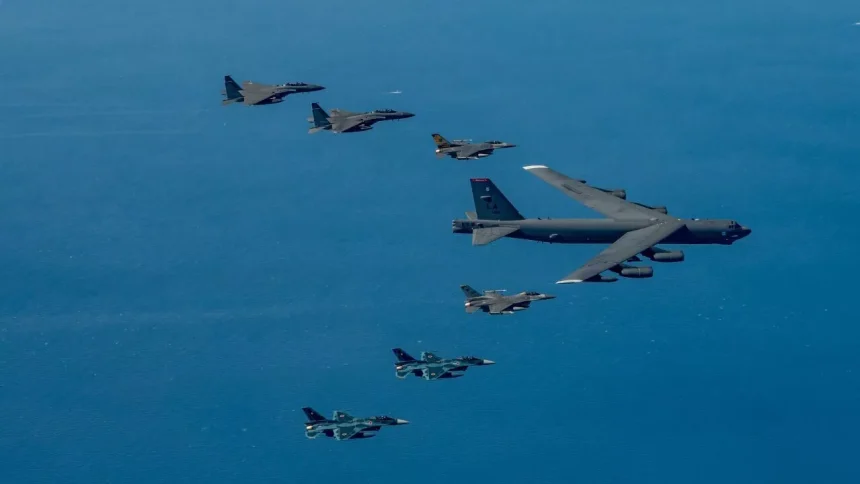In a show of military strength and cooperation, South Korea, Japan, and the United States conducted a joint air drill on Sunday, involving a US B-1B Lancer heavy bomber in response to North Korea’s recent long-range missile launch.
This trilateral exercise comes just three days after Pyongyang tested one of its most powerful intercontinental ballistic missiles (ICBMs), a solid-fueled missile capable of reaching targets in mainland US, according to military analysts.
The joint drill saw the participation of South Korean F-15K and KF-16 fighter jets alongside Japan’s F-2 jets, escorting the US B-1B bomber to a designated location south of the Korean Peninsula. South Korea’s Joint Chiefs of Staff (JCS) stated that the exercise underscored the commitment of the ROK-US alliance to what it termed “integrated extended deterrence.”
The display aimed to send a clear message to North Korea about the alliance’s readiness to counter escalating nuclear and missile threats. The JCS highlighted that the exercise demonstrated “overwhelming capability” for swift and precise strikes on simulated targets, underscoring the joint forces’ preparedness in the face of rising regional tensions.

The US B-1B Lancer, known for its high-speed supersonic performance, has a massive payload capacity of up to 75,000 pounds (34,000 kilograms) of munitions, ranging from conventional bombs to precision-guided weapons.
READ ALSO: Libya Begins Mass Arrests of Nigerians Following CAF Ruling
Notably, this is the fourth time this year the B-1B has been deployed to the Korean Peninsula and the second time the allies have conducted a trilateral aerial drill in response to North Korean provocations.
North Korea’s recent missile launch stands out as one of the most significant in its history, with both South Korean and Japanese military tracking systems noting that the missile flew higher and further than any previous ICBM.
The Korean Central News Agency (KCNA), North Korea’s state-run media outlet, hailed the missile as “the world’s strongest strategic missile,” with leader Kim Jong-un reportedly expressing satisfaction over the successful test. North Korean authorities have stated that they remain committed to expanding their nuclear capabilities, vowing to continue bolstering their strategic forces.
This launch takes place amid growing international concerns that North Korea might be supporting Russia’s war efforts in Ukraine. Reports of Pyongyang’s alleged deployment of thousands of troops to Russia, possibly to serve in Russian uniforms, have led to increased scrutiny.

If these forces were to engage directly in combat, it would represent a significant and controversial escalation in North Korea’s involvement in international conflict, with implications for both the Korean Peninsula and global stability.
The joint drill by South Korea, Japan, and the United States represents a concerted response to Pyongyang’s actions, emphasizing collective security and deterrence in a rapidly shifting regional landscape. As tensions heighten, the ROK-US alliance continues to prioritize visible demonstrations of readiness and unity in the face of North Korea’s advancing nuclear and missile programs.

